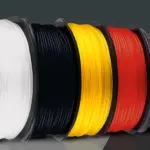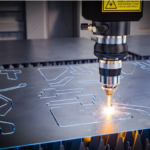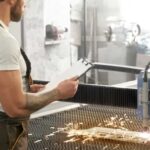PLA and PETG may sound like acronyms, but they are actually two popular contenders in the 3D printing world. One originates from corn, while the other is derived from oil. One dazzles with its array of vibrant colours, while the other boasts remarkable resilience. Typically, PETG is regarded as a blend of Acrylonitrile butadiene styrene (ABS) and PLA, with PLA being less rigid and durable than PETG.
The main difference between both 3D printing filaments is their origin or appearance and the intricate dance of properties that govern their performance. Let’s explore their unique characteristics, uncover their printing potential, and discover which filament will rule the 3D printing realm for your next masterpiece.
Table of Contents
Differences between PLA and PETG
| PLA (Polylactic Acid) | Aspects | PETG (Polyethylene Terephthalate Glycol) |
| Biodegradable thermoplastic derived from renewable resources | Material Composition | Durable thermoplastic made from petroleum-based materials |
| Biodegradable | Biodegradability | Not biodegradable but recyclable |
| Generally lower tensile strength and durability compared to PETG | Strength and Durability | Superior tensile strength and durability compared to PLA |
| Lower (around 180-220°C) | Printing Temperature | Higher (around 220-250°C) |
| Lower heat resistance | Heat Resistance | Higher heat resistance |
| Less chemical resistance compared to PETG | Chemical Resistance | Better chemical resistance compared to PLA |
| May have slightly less clear finish depending on specific formulation and printing conditions | Transparency | Excellent optical clarity similar to glass, ideal for applications requiring transparency. |
What is PLA?
As you enjoy your meal, you reach for a sturdy, reliable, eco-friendly fork made from Polylactic Acid, also known as PLA, is biodegradable thermoplastic polyester resin derived from renewable resources. It is one of the most popular 3D printing materials due to its ease of use, low odour, and minimal warping during printing. PLA filament is commonly used for fused deposition modelling (FDM), prototyping, hobbyist projects, and consumer goods. It has a lower melting temperature, simplifies the 3D printing process, requires less energy for heating, operates efficiently with lower nozzle and bed temperatures, and facilitates swift cooling.
Properties of PLA
- Density: 1210-1430 kg/m3
- Melting Point: 150 to 160 °C (302 to 320 °F; 423 to 433 K)
- Solubility in Water: 0 mg/ml
- Heat-resistant: up to 110 °
What is PETG?
The display that even shines in rain, summer, and winter is made up of Polyethylene Terephthalate Glycol (PTEG), an extrusion material that is a glycol-modified variant of polyethylene terephthalate, boasting exceptional resistance to chemicals, strength, and durability. It is an oil-based polymer with excellent layer adhesion, making it less prone to warping and producing strong, functional parts. With impressive physical properties, PETG is more flexible and has greater UV resistance and water resistance, making it a common use for mechanical parts, functional prototypes, and outdoor uses that require durability and toughness.
Properties of PETG
- Chemical Formula: (C10H8O4)n
- Molar Mass: 10–50 kg/mol, varies
- Density:
-1.38 g/cm3, 20 °C
-1.370 g/cm3, amorphous
-1.455 g/cm3, single crystal - Melting Point: > 250 °C (482 °F; 523 K) 260 °C
- Boiling Point: > 350 °C (662 °F; 623 K) (decomposes)
- Solubility in Water: Practically insoluble
- Thermal Conductivity: 0.15 to 0.24 W/(m·K)
Elevate your 3D printing experience with Any Shape Plastics! From selecting the perfect filament to mastering printing techniques, we’re your go-to partner for success. Contact us today and level up your 3D printing game.
Similarities between PLA and PETG
Versatility:
PLA and PETG are incredibly versatile materials that can be used for various applications. Whether you’re creating prototypes, intricate models, or functional parts, both PLA and PETG offer the flexibility and adaptability needed to bring your designs to life. Their versatility makes them suitable for various industries, including manufacturing, engineering, healthcare, and education.
Compatibility:
One of the significant advantages of PLA and PETG is their compatibility with most desktop 3D printers. Whether you have a budget-friendly printer or a high-end professional model, you can typically use PLA or PETG without any issues. This compatibility ensures that users of all skill levels, from beginners to experienced professionals, can utilise these materials for their projects without worrying about compatibility issues.
Wide Availability:
PLA and PETG filaments are easily obtainable from numerous manufacturers worldwide. This vast availability implies that users can access a diverse range of colours, formulations, and quality options. Whether you have a preferred brand or are searching for specific colours or special filaments, chances are high that you’ll find what you need within the PLA and PETG product offerings.
Environmental Impact:
While PLA and PETG have different environmental properties, they both contribute positively to sustainability efforts in 3D printing. PLA is derived from renewable resources such as corn starch or sugarcane and is biodegradable, meaning it can break down naturally over time, reducing environmental impact. On the other hand, PETG is recyclable, allowing for the reuse of materials and minimising waste. Both options offer environmentally friendly alternatives to traditional plastics, making them popular choices for eco-conscious users.
Ease of Printing:
PLA and PETG are known for their ease of use during printing. They exhibit minimal warping and require little to no special equipment or settings, making them suitable for beginners and experienced users alike. Additionally, both materials offer excellent adhesion to build surfaces, resulting in reliable and high-quality prints.
Food Contact Safe:
Both PLA and PETG are considered safe for food contact applications when used in accordance with regulations. PLA is commonly used for producing disposable food containers, cups, lids, and utensils due to its biodegradability and food-safe properties. Similarly, PETG is widely utilised in the food packaging industry for bottles, jars, trays, and clamshell containers due to its transparency, durability, and chemical resistance.
PETG vs PLA: Which Material is Right for You?
Choosing the right filament for your 3D printing projects is crucial for achieving the desired results. PETG and PLA are two popular options with distinct characteristics and advantages. Here are some factors to consider when deciding which material is right for you:
- Project Requirements: How do the unique properties of PLA and PTEG align with the specific demands of your 3D printing projects?
- Priorities: Are you prioritising strength, durability, and heat resistance (PETG), or eco-friendliness, ease of use, and colour variety (PLA)?
- Considerations: Which factors, such as biodegradability, printing temperature, and aesthetic preferences, weigh heaviest in your decision-making process?
- Future Plans: How might your choice of filament material impact your future projects and sustainability goals?
For Beginners: Start with PLA due to its ease of use, lower printing temperature, and minimal warping. Focus on mastering the basics of 3D printing before exploring more advanced materials like PETG.
For 3D Printing Enthusiasts: Experiment with PETG to leverage its superior strength, durability, and heat resistance for more demanding projects. Take advantage of PETG’s versatility to explore new applications and push the boundaries of your 3D printing capabilities.
Conclusion
In the riveting debate between PETG and PLA, we’ve explored the unique attributes that make each filament a star in the 3D printing universe. Whether you lean towards the vibrant versatility of PLA or the robust resilience of PETG, the choice ultimately depends on your project’s specific needs. Now that you know about these fascinating materials, it’s time to unleash your creativity and bring your ideas to life. Contact us today, and let’s unlock the printing potential hidden within your fingertips. Remember, the only limit is your imagination, and anything is possible with the right filament by your side.









